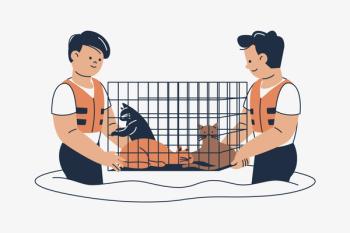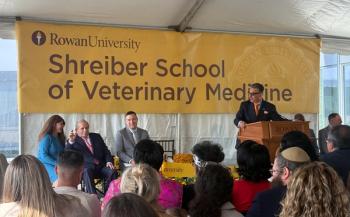
AVMA gets mixed reaction to ear-crop policy
National Report - The AVMA Executive Board's recent decision asking breed clubs to eliminate ear cropping and tail docking from breed standards earned praise from animal-rights groups and sharp criticism from the American Kennel Club.
National Report — The AVMA Executive Board's recent decision asking breed clubs to eliminate ear cropping and tail docking from breed standards earned praise from animal-rights groups but sharp criticism from the American Kennel Club (AKC).
Cosmetic surgery policy: a timeline
The policy, which is reviewed every five years, now states: "The AVMA opposes ear cropping and tail docking of dogs when done solely for cosmetic purposes. The AVMA encourages the elimination of ear cropping and tail docking from breed standards."
Gail Golab, head of the AVMA Animal Welfare Division, says the policy adopted in late November is consistent with the approach the AVMA has taken since at least 1976. "Philosophically there is no change," she says. "We've never come out with a statement in support of ear cropping and tail docking."
Still, the American Kennel Club (AKC) blasted the AVMA for the revision.
"Mislabeling these procedures as 'cosmetic' is a severe mischaracterization that connotes a lack of respect and knowledge of history and the function of purebred dogs," according to the AKC.
Golab wasn't surprised.
"We've revised our policy in the past, most recently in 1999, and they had a similar reaction at that time and in 1976," she says. "They feel strongly about their breed standards."
AKC breed standards
Breed standards are established and maintained by AKC parent clubs. Each of the 158 AKC registered breeds is stewarded by a breed-specific parent club, and the AKC believes owners, in consultation with their veterinarians, have the right to make decisions regarding appropriate care and treatment of their pets, including ear cropping and tail docking.
Currently, 13 breeds are routinely cropped, while tail docking is common in 48 breeds, according to the AKC. Eleven breeds are subject to both.
AKC's policy on ear cropping and tail docking states:
"The American Kennel Club recognizes that ear cropping, tail docking and claw removal, as described in certain breed standards, are acceptable practices integral to defining and preserving breed character and/or enhancing good health."
It's a policy the Humane Society Veterinary Medical Association (HSVMA), the Humane Society of the United States (HSUS) and the People for the Ethical Treatment of Animals (PETA) would like to see changed.
The groups praised the AVMA, but urged it to go further by strengthening its positions on declawing and devocalization. They also called on the AKC to change its breed standards.
"We are very happy that they (AVMA) have come out with a much stronger statement than the previous one," says Barbara Hodges, DVM, MBA, a veterinary consultant with the HSVMA. "The piece of the puzzle in their statement that has been missing is their encouragement of the breed clubs to eliminate ear cropping and tail docking from breed-club standards. This gives veterinarians some back-up for not performing these procedures. It stimulates a re-examination of some people's perspectives."
The issue has been a hot-button topic for years within veterinary medicine. A VIN Tips feature in the June issue of DVM Newsmagazine sparked several Letters to the Editor and heated debate among veterinarians.
"I think a number of veterinarians have been uncomfortable with these procedures for a long time," Golab says. "A lot of the feedback we've been getting has been from veterinarians who are very relieved the AVMA made the revision because it gives them back-up for a decision they're already making."
Of 70 veterinarians who responded to a DVM Newsmagazine online poll, 80 percent say they are in favor of banning cosmetic surgeries.
Many veterinary colleges no longer teach the procedures, which shows they are becoming less popular, according to Hodges.
"There is a resistance by the new generation of students," she says. "They are speaking up and saying as they enter the profession that they don't want to perform these procedures, that they don't think the medical and health risks to the animal are necessary."
Hodges hopes the policy revision will prompt veterinarians to promote the changes and help educate the community.
Nancy Peterson of the HSUS calls the new AVMA policy a step in the right direction, but says to fully stop the procedures breed standards must be changed, which may require legislative action.
"It's not the AKC per se that sets these standards, it's the breed clubs," she says. "They feel this is what makes their breed their breed, some physical aspect. Those of us in animal welfare strongly disagree. How do you get to the breed clubs when they are not willing to voluntarily change? It might be time for legislation."
After the AVMA policy change was announced, PETA sent a letter to AKC President and CEO Dennis Sprung urging him to ban the procedures and calling on the AKC to alter breed standards.
Some breeders support change
AVMA says it has heard from a number of breeders, and many support the revised policy, Golab says.
"So much depends on what happens with breed standards," she says. "As long as there is a demand for it and as long as the procedures are not regulated, there will certainly be some veterinarians who will perform them. When the Animal Welfare Committee looks at these issues, the first question we ask is why do we perform this practice. The answer actually can go a long way in pointing the AVMA in the direction of policy. If there isn't a good scientific justification for the procedure, a clear benefit to the animals, or protection to human health, we ask whether or not it should be performed."
If breed standards persist, so will the practice of ear cropping and tail docking, Golab admits.
There has been some movement in particular breed clubs to allow uncropped ears and undocked tails, Golab says, and in some rare instances those animals have won championships, but it is very breed-dependent.
Any dog can enter any competition, with or without cropped ears and docked tails, according to Lisa Peterson, director of club communications for the AKC.
And some breed standards now include mention of the acceptability of ears and tails left in their natural state (the Boxer standard allows natural ears that meet certain qualifications, although it still recommends that "an undocked tail should be severly penalized").
"Although rarely will you see pictures or illustrations providing guidance for the breed that show dogs with ears and tails in their natural state," Golab adds.
The revamped AVMA policy doesn't mean breed standards will change.
"AVMA is a nonprofit organization that makes recommendations to its membership," she says. "Our opposition is not the equivalent of a ban."
Trying to limit any procedures on a state-by-state basis could be problematic.
Although the AVMA opposes ear cropping and tail docking, if a state or city were to try to ban the procedures, the association wouldn't necessarily jump on board, Golab says, stressing that it would come down to enforcement of veterinary-practice acts.
Newsletter
From exam room tips to practice management insights, get trusted veterinary news delivered straight to your inbox—subscribe to dvm360.




